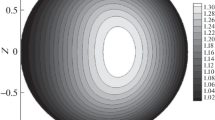Abstract
A mathematical model of a magnetic tornado in a magnetohydrodynamic plasma, based on the apparatus of continuum mechanics and Maxwell’s electrodynamics, is proposed. In the context of two specific examples, the mutual influence of plasma and magnetic field dynamics, which gives rise to a magnetic tornado, is studied. Of particular interest is the interaction of a plasma and a magnetic field when an ideal plasma moves along the magnetic field lines. In this case, the study of a magnetic tornado is reduced to a purely hydrodynamic case of a tornado in atmospheric air. The numerical results obtained give theoretical confirmation of the existence of vortical formations observed in the chromosphere of the solar plasma, identified with a magnetic super-tornado.



Similar content being viewed by others
REFERENCES
E. Parker, “Nanoflares and the solar X-ray corona,” Astrophys. J. 330, 474–479 (1988).
P. Brandt, G. Scharmer, S. Ferguson, R. Shine, and T. Tarbell, “Vortex flow in the solar photosphere,” Nature 335, 238–240 (1988).
J. Bonet, I. Marquez, J. Sanchez Almeida, I. Cabello, and V. Domingo, “Convectively driven vortex flows in the Sun,” Astrophys. J. 687, L131–L134 (2008).
J. Bonet et al., “SUNRISE/IMaX observations of convectively driven vortex flows in the Sun,” Astrophys. J. 723, L139–L143 (2010).
S. Wedemeyer-Böhm, E. Scullion, O. Steiner, L. R. van der Voort, J. de la Cruz Rodriguez, V. Fedun, and R. Erdélyi, “Magnetic tornadoes as energy channels into the solar corona,” Nature 486, 505–508 (2012).
D. V. Nalivkin, Hurricanes, Storms, and Tornadoes: Geographical Features and Geological Activities (Nauka, Leningrad, 1969) [in Russian].
A. Yu. Varaksin, M. E. Romash, and V. N. Kopeitsev, Tornados (Fizmatlit, Moscow, 2011) [in Russian].
S. P. Bautin, Mathematical Modeling of Strong Gas Compression (Nauka, Novosibirsk, 2007) [in Russian].
L. D. Grasso and W. R. Cotton, “Numerical simulation of a tornado vortex,” J. Atm. Sci. 52 (8), 1192–1203 (1995).
J. B. Klemp and R. B. Wilhelmson, “The simulation of three dimensional convective storm dynamics,” J. Atm. Sci. 35 (6), 1070–1096 (1978).
R. Rotunno, “Numerical simulation of a tornado vortex,” J. Atm. Sci. 34 (12), 1942–1956 (1977).
M. B. Gavrikov and A. A. Taiurskii, Preprint No. 42, IPM RAN (Keldysh Inst. of Applied Mathematics, Russian Academy of Sciences, Moscow, 2019).
M. B. Gavrikov and A. A. Taiurskii, “A mathematical model of tornado,” J. Phys. Conf. Ser. 1336 (012001), 1–11 (2019).
H. Alfven and C.-G. Falthammer, Cosmical Electrodynamics (Oxford Univ. Press, London, 1963).
N. V. Filippov, “Review of experimental studies of plasma focus performed at Kurchatov Institute,” Fiz. Plazmy 9 (1), 25–44 (1983).
L. D. Landau and E. M. Lifshitz, Electrodynamics of Continuous Media (Nauka, Moscow, 1982; Butterworth-Heinemann, Oxford, 1984).
S. Lundquist, “Experimental investigation of magneto-hydrodynamic waves,” Phys. Rev. 76 (12), 1805–1809 (1949).
T. Karman, “Über laminare und turbulente Reibung,” Z. Angew. Math. Mech. 1, 244–247 (1921).
V. V. Sychev, “On the motion of a viscous electrically-conducting liquid under the action of a rotating disk in the presence of a magnetic field,” J. Appl. Math. Mech. 24 (5), 1360–1364 (1960).
V. P. Shidlovskii, “Study of viscous electrically conducting fluid flow driven by a rotating disk in an axial magnetic field,” Magn. Gidrodin. 6 (1), 93–97 (1966).
A. G. Kulikovskii and G. A. Lyubimov, Magnetohydrodynamics (Addison-Wesley, Reading, Mass., 1965; Logos, Moscow, 2005).
Modern Numerical Methods for Ordinary Differential Equations, Ed. by G. Hall and J. M. Watt (Clarendon, Oxford, 1976).
R. E. Bellman and R. E. Kalaba, Quasilinearization and Nonlinear Boundary-Value Problems (Elsevier, New York, 1965).
L. D. Landau and E. M. Lifshitz, Fluid Mechanics (Butterworth-Heinemann, Oxford, 1987; Nauka, Moscow, 1988).
P. G. Drazin, Introduction to Hydrodynamic Stability (Cambridge Univ. Press, Cambridge, 2002).
M. B. Gavrikov and A. A. Taiurskii, Preprint No. 48, IPM RAN (Keldysh Inst. of Applied Mathematics, Russian Academy of Sciences, Moscow, 2020).
M. B. Gavrikov and A. A. Taiurskii, Preprint No. 42, IPM RAN (Keldysh Inst. of Applied Mathematics, Russian Academy of Sciences, Moscow, 2020).
Funding
This work was supported by the Moscow Center for Fundamental and Applied Mathematics, agreement with the Ministry of Science and Higher Education of the Russian Federation no. 075-15-2019-1623.
Author information
Authors and Affiliations
Corresponding authors
Additional information
Translated by E. Chernokozhin
Rights and permissions
About this article
Cite this article
Gavrikov, M.B., Tayurskii, A.A. Mathematical Model of a Magnetic Tornado. Comput. Math. and Math. Phys. 61, 1532–1545 (2021). https://doi.org/10.1134/S0965542521090086
Received:
Revised:
Accepted:
Published:
Issue Date:
DOI: https://doi.org/10.1134/S0965542521090086



